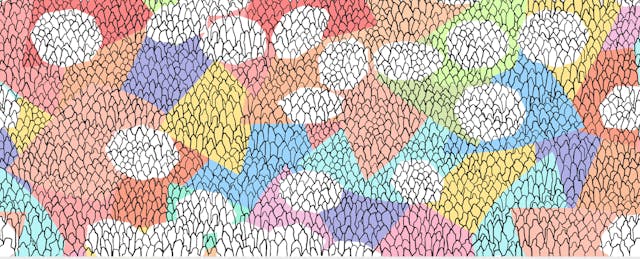Many believe that for learning to be personal, it must be individualized. But over-individualization can be isolating when we over-rely on digital programs that individualize curriculum and unintentionally track learners. What’s more, it strips students of their agency and autonomy and strips learning of curiosity and serendipity.
At its extreme, this digitized brand of personalized learning is dehumanizing: It’s taking the humanity out of the human condition of learning, and it’s inadvertently taking the person out of personalization.
But that doesn’t mean that we should be remiss in advocating for personalization in schools. Children deserve an education that is inherently meaningful and personal to them, and it should be one that humanizes—instead of dehumanizes—the learning process. It’s time that knowledgeable, sentient educators reclaim personalized learning as a humanized pedagogy—one that cultivates student agency and keeps equity and inclusion at the center.
Here’s how we can start.
Build an Accessible and Inclusive Curriculum
It is possible to sustainably personalize learning by widening the scope of individual tasks and designing them to have varied entry points for a diverse group of learners, promoting access to an equitably rigorous curriculum.
In “Mathematical Mindsets” by Stanford math professor Jo Boaler, she advocates for complex instruction (a term coined by other researchers at Stanford School of Education). While Boaler indirectly describes it as a method for differentiation, it holds the same principles. Complex instruction has three major components:
- multiple-ability curricula;
- specific instructional strategies that teach collaboration skills and norms between students; and
- actively working against issues of status, privilege, or injustice to ensure all students have access to a rigorous curriculum.
To create a multi-ability curriculum, Boaler recommends using “low-floor, high-ceiling tasks” that allow children to solve the same problems using different methods. Children can choose methods that match their ability level, allowing them to personalize the learning experience on their own behalf.
Take this task, for instance, that I adapted from “Illustrative Mathematics.” After viewing it together with my students, they were tasked with finding the area of the different shapes, and determining which figures had the smallest and greatest area.

Under the principles of complex instruction, students were able to approach this task in a variety of ways. Some simply counted the squares, not yet able to break the shapes into rectangles. Others did just that, using their knowledge of multiplication to compute the areas of parts of the shapes. Some even noticed that all of the shapes were cut from a 10x10 grid, and used the negative space to calculate the area.
Here’s an example of their work samples below.

In these examples, we can see complex instruction and humanized personalization in action. The children themselves personalized this task by deciding autonomously which tactic they would use to solve the problem. What’s more, they were able to talk with one another about various strategies for solving the problem, which helps build classroom culture through dialogue and discourse.
These practices preserve equity in the classroom because they allow every children to converge around a common task, helping all learners feel as though they belong within the culture of mathematics in the classroom, regardless of ability.
Cultivate Agency and Autonomy
The experience above is wrought with student agency and autonomy. It allows each learner to go inward and ask themselves what assets they have to bring to each learning task. In one of the examples below, in particular, a student used colors to code differently-sized rectangles, helping them keep track of their thinking in a way that worked for them.

While it’s true that perhaps these strategies could surface within a curriculum that’s individualized, it’s unlikely. To get my students to a point where they are able to choose strategies independently and problem-solve with autonomy, I have to intentionally engineer the learning environment to promote autonomous decision-making.
In “Culturally Responsive Teaching” by Zaretta Hammond, she encourages teachers to guide students from being dependent to independent learners. With our most vulnerable populations, she argues, far too many students are the former, requiring a significant amount of support to problem-solve and make decisions autonomously.
By building an inclusive curriculum through complex instruction, we can naturally guide all learners towards independence, embedding learner-driven personalization into the culture of the classroom. We do so not only through repeated opportunities for autonomous problem-solving; we do so by creating a classroom culture that values collaboration and human connection as a foundation for building agency and autonomy.
It’s also important to allow children to reflect on their learning journeys each and every day. The aforementioned multi-ability exercise not only encourages students to work together; it allows them to reflect together on various methods for approaching problems. Each day within our math workshop, we examine and evaluate each approach, continuously creating new options for students to use when solving problems on their own.
In this way, the diversity of thinking in the classroom compounds upon itself, building equity and access in a way that many personalized learning technologies cannot.
Humanize Technology Integration
Technology has the power to radically change the way we communicate with one another, and transform our classrooms in ways that are unimaginable. When humanizing technology integration, I like to make sure I do so in a way that (1) minimizes complexity; (2) maximizes individual power and potential; (3) reimagines learning experiences; and most importantly (4) preserves or enhances human connection in the classroom.
One tool that does this remarkably well is Seesaw, a digital portfolio available on both desktop and mobile devices. Using Seesaw, students can show their thinking in many different ways—through pictures, drawings, voice recordings, and videos. The tool minimizes the complexity of documenting all the ways that students express their unique knowledge and skills.
Using Seesaw, parents also have visibility into what their kids are doing. Through pictures and videos, they can see concrete artifacts of learning to ask their child about. The pictures above were documented in Seesaw and sent home to families, enhancing conversations around learning between my students and their parents.
Reclaiming Personalized Learning
It’s important to remember that the push for personalization came about in an effort to create equitable spaces where all students get what they need. While it’s true that technology can provide some benefits that make learning all the more meaningful and personal, digital tools that individualize curriculum do not achieve this end.
It’s time that we, educators, reclaim the term personalization as a pedagogy that is enacted by human beings, and only use technology when it preserves or enhances human connection. It’s time that we redefine personalized learning as a pedagogy that re-humanizes our schools and removes technologies that pose a threat to equity and humanity. We can do this if we hold equity and inclusion at the center of our intentions for personalization.


